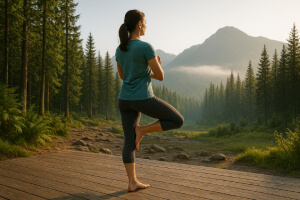Hiking preparation is more than just choosing the right trail and packing your gear. Your fitness is going to affect your endurance, your safety, and even your enjoyment for either a short weekend trek or a very long multi-day adventure. It would be wise to train for strength, flexibility, and endurance to avoid injuries, and to improve your ability to deal with changes in terrain and weather.
Here are some great fitness tips that can train your body and mind for hiking, from conditioning to recovery.
Build a Strong Foundation: Start with General Fitness

Before working on specific hiking muscles, it is important to look at your general fitness. Hiking works the entire body, such as legs, core, back, and cardiovascular system. Begin with a regular workout to build endurance and strength in different muscle groups.
Walking, jogging, or cycling three or four times a week keeps your cardiovascular system in check. Follow this with light weight training: squats, lunges, planks, and step-ups are all great for building stability and leg strength. If you have never exercised before, take it slow; increase the time or intensity of your training very gradually to avoid burnout or overtraining.
Key Exercises for Overall Conditioning
- Squats and lunges: These work the quadriceps, hamstrings, and glutes mainly targeted while hiking.
- Step-ups: Promote balance and simulate the uphill climbing motion.
- Planks and side planks: Develop core stability that assists with posture and maintaining balance on uneven terrain.
- Jump-rope or stair climbing for endurance-and cardiovascular-building.
Train with Terrain in Mind

Hiking hardly ever happens on the flat. The trail might have steep climbs down rocky slopes and shifting surfaces. When one trains on a similar terrain, their body will work in adaptation to the challenges.
Whenever possible, train outdoors on trails, hills, or uneven surfaces. Your balance and coordination will develop while you are strengthening the stabilizing muscles in your ankles and feet. For others in the city, staircases, bridges, or a treadmill will do the trick to simulate elevation gain. Even better-whether on the treadmill or track-gladly carry a light backpack to start conditioning your body for the extra load you’ll face on the trail.
Practical Training Ideas
- Hill repeats: walk or run uphill for several minutes, recover by walking down.
- Take a trail walk once a week-so you become accustomed to dirt, gravel, and roots.
- Increase backpack weight progressively as you get stronger.
Focus on Core Strength and Stability
The core supports the spinal column and serves to keep one in balance when carrying a backpack or stepping on irregular rocks. Core work is essential in long-distance trekking, when fatigue can alter the formation of the body.
Perform 10-15 minutes of core training daily. Movements such as mountain climbers, bicycle crunches, and bird dogs strengthen the muscles responsible for stabilizing the body. It is equally essential to work on strengthening the lower back and hips for proper balancing so that knees and ankles feel less strain.
Effective Core Exercises
- Bird dogs: Strengthen the lower back and enhance coordination.
- Russian twists: Work oblique muscles for rotation.
- Leg raises: Work the lower abs, which aid posture during ascents.
- Bridges: Strengthen hips and glutes used going uphill.
Integrating Core Workouts into Routine
Add core exercises following your weight workouts or cardio sessions. Perform two or three sets of each of the movements, paying attention to form rather than speed. Being consistent will develop your balance and endurance.
Balance and Flexibility

Meanwhile, balance and flexibility training sometimes get the shaft in hiking preparation, and yet both are crucial to preventing falling and injury. Quick responses and control are needed as there is uneven ground, sometimes loose rocks, and slippery roots.
Balance exercises standing on one leg or using a balance board would improve coordination. Yoga or dynamic stretching would increase flexibility of the hips, calves, and hamstrings, which eases the tightness encountered during a lengthy trekking. Also, stretching promotes recovery and keeps muscles from tightening immediately after strenuous descending.
- Balance: practice tree pose or warrior III from yoga.
- Start with ankle circles and hip openers in your warm-up.
- Finish exercises with hamstring and calf stretches to maintain mobility.
Build Endurance for Long Distances
Endurance is necessary when doing multi-day hikes or trails with substantial elevation gains. Cardiovascular training should be designed to emulate the sustained effort on long treks.
Engage in low-impact aerobic activities such as brisk walking, swimming, or cycling from 30 to 60 minutes per session, several times a week. Increase duration and intensity along with endurance. Take longer hikes or walks on the weekends to deny the time and effort it takes to be on the trail for several hours.
- Alternate between steady-state cardio and interval training for stamina building.
- Keep track of progress by visualizing distance, elevation, and pace.
- Consistency comes first, as frequent moderate training excels over training intervals of high intensity.
- Lengthen walking or hiking sessions by 10 to 15 minutes weekly.
- Gradually increase elevation and distances.
- Breathing control with pacing helps create sustain energy for long-distance treks.
Rest and Recovery

Recovery outweighs the training. The body cannot rebuild muscle tissue or adjust to a new strain if proper rest is not provided. The risk of injury can increase from overtraining, especially if it is before a demanding hike.
Consider one or two rest days in the entire week. During rest days, consider light stretching, foam rolling, or gentle walks. Always make sure to drink lots of water, eat healthy, and get adequate sleep for muscular restoration. Listen to your body; if you start feeling unnormally sore and fatigued, consider taking additional rest before training again.
Mental Preparation and Mindset

Physical fitness is only part of hiking preparation, mental readiness is just as important. Staying focused, confident, and adaptable helps you handle unexpected trail challenges, from sudden weather changes to tough terrain.
Practice visualization techniques by imagining yourself completing sections of your hike successfully. Break long trails into smaller, manageable goals to keep motivation high. Incorporating mindfulness or meditation into your routine can also improve focus, reduce stress, and help you stay calm during physically demanding moments.
The Last Step to Become Trail Ready
Truly, a hiking-prepared body takes time, consistency, and a diversified approach. Stronger, enduring, flexible, and well-recovered equate to safer and more enjoyable hikes.
More than the varieties of terrain, a stay on top of a healthy diet and build stamina in phases, develop the physical and mental endurance needed for confidently tackling the challenging trails.
